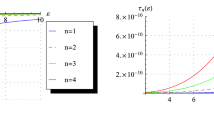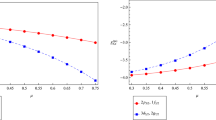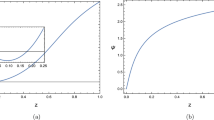Abstract
The Chern–Simons (CS) gauge field theory was widely used to explain and to deeper understand the fractional quantum Hall effects. In this work, we apply the Chern–Simons gauge field theory to a two-dimensional (2D) electron-hole (e-h) system in a strong perpendicular magnetic field under the influence of the quantum point vortices creating by the Chern–Simons (CS) gauge field. The composite electron–hole particles with equal integer positive numbers ϕ of the attached quantum point vortices are described by the dressed field operators that obey to either the Fermi or Bose statistics depending on the even or odd numbers ϕ. It is shown that the phase operators, as well as the vector and scalar potentials of the CS gauge field, depend on the difference between the electron and the hole density operators. They vanish in the mean field approximation, when the average values of the electron and of the hole densities coincide. Nevertheless, even in this case, quantum fluctuations of the CS gauge field lead to new properties of the 2D e–h system. It is found that the numbers of vortices attached to each electron and hole are the same. This result is not obvious, and a different distribution of vortices in the environment of electron–hole pairs could be expected. A simple analytical formula is obtained for the shift of the magnetoexciton energy level at the point k = 0 due to the influence of the CS gauge field.
Similar content being viewed by others
REFERENCES
S. S. Chern and J. Simons, Ann. Math. 99, 48 (1974).
F. Wilczek, Phys. Rev. Lett. 48, 1144 (1982);
F. Wilczek, Phys. Rev. Lett. 49, 957 (1982).
R. Jackiw and S.-Y. Pi, Phys. Rev. D 42, 3500 (1990).
S. C. Zhang, T. H. Hansson, and S. Kivelson, Phys. Rev. Lett. 62, 82 (1989).
J. K. Jain, Phys. Rev. Lett. 63, 199 (1989).
W. Beugeling, M. O. Goerbig, and C. Morais Smith, Phys. Rev. B 81, 195303 (2010).
G. Dunne, R. Jackiw, and C. Trugenberger, Phys. Rev. D 41, 661 (1990).
S. A. Moskalenko, V. A. Moskalenko, P. I. Khadzhi, I. V. Podlesny, M. A. Liberman, and I. A. Zubac, Mold. J. Phys. Sci. 17, 52 (2018).
S. A. Moskalenko, V. A. Moskalenko, I. V. Podlesny, and I. A. Zubac, Semiconductors 53, 2055 (2019).
A. P. Prudnikov, Yu. A. Brychkov, and O. I. Marichev, Integrals and Series: Special Functions (CRC, Boca Raton, FL, 1986).
Author information
Authors and Affiliations
Corresponding author
Ethics declarations
The authors declare that they have no conflict of interest.
Rights and permissions
About this article
Cite this article
Moskalenko, S.A., Moskalenko, V.A., Podlesny, I.V. et al. Two-Dimensional Electron-Hole System under the Influence of the Chern–Simons Gauge Field Created by the Quantum Point Vortices. Semiconductors 55 (Suppl 1), S35–S48 (2021). https://doi.org/10.1134/S1063782621080145
Received:
Revised:
Accepted:
Published:
Issue Date:
DOI: https://doi.org/10.1134/S1063782621080145




